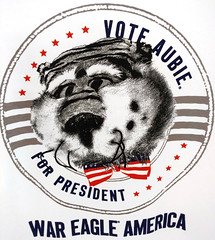- My Forums
- Tiger Rant
- LSU Recruiting
- SEC Rant
- Saints Talk
- Pelicans Talk
- More Sports Board
- Coaching Changes
- Fantasy Sports
- Golf Board
- Soccer Board
- O-T Lounge
- Tech Board
- Home/Garden Board
- Outdoor Board
- Health/Fitness Board
- Movie/TV Board
- Book Board
- Music Board
- Political Talk
- Money Talk
- Fark Board
- Gaming Board
- Travel Board
- Food/Drink Board
- Ticket Exchange
- TD Help Board
Customize My Forums- View All Forums
- Show Left Links
- Topic Sort Options
- Trending Topics
- Recent Topics
- Active Topics
Started By
Message
Monocular/Binocular/Spotting scope for ~100 yard range target viewing [update]
Posted on 1/11/17 at 8:59 am
Posted on 1/11/17 at 8:59 am
Couple of times I've gone to the range without a scoped rifle and realized I can't see the holes in a paper target too far beyond 30 yards depending on the caliber. Maybe up to 40-50 with a splatter target and a large caliber. I can see everything fine out of a 12x scope but taking a rifle with a 12x scope just for looking at bullet holes is a PITA.
I have some 8x25 Nikon binoculars. Haven't tried them at the range yet but for 100 yard shots I think it's still going to be inadequate.
I have a $100 Amazon gift card left over from Christmas. Thinking I might put it towards something useful. Anyone use a binocular/monocular in place of a spotting scope on ~100 yard ranges? I don't see myself ever using them beyond 100 yards as the long distance range I shoot at has electronic targets. A good set of Binoculars or a monocular might have more use than just at the range. Not sure how well they would work for my intended purpose though. Any suggestions? I don't have to keep it under the $100 price tag of the gift card but I would prefer the price to be closer to $100 than $200+
Or should I fork down the $200+ on a decent if unspectacular spotting scope?
I have some 8x25 Nikon binoculars. Haven't tried them at the range yet but for 100 yard shots I think it's still going to be inadequate.
I have a $100 Amazon gift card left over from Christmas. Thinking I might put it towards something useful. Anyone use a binocular/monocular in place of a spotting scope on ~100 yard ranges? I don't see myself ever using them beyond 100 yards as the long distance range I shoot at has electronic targets. A good set of Binoculars or a monocular might have more use than just at the range. Not sure how well they would work for my intended purpose though. Any suggestions? I don't have to keep it under the $100 price tag of the gift card but I would prefer the price to be closer to $100 than $200+
Or should I fork down the $200+ on a decent if unspectacular spotting scope?
This post was edited on 1/13/17 at 7:19 am
Posted on 1/11/17 at 9:05 am to DeoreDX
Posted on 1/11/17 at 9:17 am to DeoreDX
Posted on 1/11/17 at 9:22 am to nismosao
quote:
Konus Spotting Scope
Have this and love it for 100 yard range.
That Konus was actually at the top of my lift for cheap spotting scopes. Didn't know if I could get away with binoculars or a monocular instead. Not sure the Voretex 10x36 monocular would give me enough detail at 100 yards.
For Binoculars I was looking at Redfield too as I trust the brand for low cost optics.
Redfield 10x50 Binoculars
Posted on 1/11/17 at 9:22 am to DeoreDX
I have a shitty Burris spotting scope. It was free with a scope.
Id spend the money on decent quality wether you get a spotting scope or use binos on a tripod. I would suggest opening up the budget. A shitty spotting scope isnt worth using.
Id spend the money on decent quality wether you get a spotting scope or use binos on a tripod. I would suggest opening up the budget. A shitty spotting scope isnt worth using.
Posted on 1/11/17 at 11:27 am to DeoreDX
The Konus is legit as far as quality goes.
Posted on 1/13/17 at 8:48 am to DeoreDX
I had talked myself into getting the Konus 80mm spotting scope. Did a lot of reading up on it and I kept seeing it compared to the Celestron 80mm spotting scope. I recognize the Celestron name from higher end astronomy telescopes. They seem to be very highly regarded in the birding and astronomy communities. I saw Optics Planet put the 80mm with tripod on sale for $142 and you can buy from Optics Planet through Amazon so I could use my gift card. The one feature that really pushed me towards the Celestron instead of the Konus was the fact you can use a standard telescopic T-ring to camera adapter to mount an interchangeable lens camera directly to the scope. Obviously a feature born from Celestron's astronomy background. As a photography enthusiast that feature is really appealing to me as it open up digiscoping/astrophotography for me so this will definitely see use outside of the shooting range.

Couple of other products I considered. One was a Lens2Scope adapter. On Amazon for $79 I could convert one of my Nikon F mount telephoto lenses into a scope. It is supposed to give you focal length/10 magnification. My longest F mount manually operated lens is 200mm so it would have been a 20x magnification spotting scope. I have a 300mm but it's of pretty low quality. Probably still better quality than the glass I would get in a cheap spotting scope. Might be a interesting option for photography equipment owning folks looking to use their investment of high end phtography glass as a spotting scope.
LINK

To get ED glass in a spotting scope you are looking at a minimum $400-500. ED glass is what is used in high end optics. When you bend light through a lens some wavelengths bend differently from others and that causes the purple fringing and loss of detail at high magnification. You could get a Nikon 300 F4.5 ED-IF used for about $200 spend $79 on the lens2scope adapter and get a "30x70mm" spotting scope using some of the best glass money can buy. The 300 f4.5 ED-IF was a $900+ lens when it was new in the 80's/90's dollar. I did seriously consider this route too. If I run across a cheap used copy of the 300 f4.5 ED or ED-IF I'll probably buy it just to try this out.
Another option I considered was a reflex/mirror spotting scope also by Celestron on sale at Optics planet for $132. Celestron C90 would come with two eye pieces (12.5mm and 32mm) giving you 39x and 100x magnification. A mirror design has the advantage of bouncing light instead of bending it do you won't get the detail losing effects that bending light through non-ED glass makes so you get a more detailed sharper image. They are sharper and more detailed but not as "bright". The C90 gets nothing but great reviews. All metal constructed it's large and heavy compared to a traditional glass not mirrors spotting scope. Also can use a standard T ring to attach a camera. There are some pretty spectacular moon crater photos made from this combination. I decided I wanted brightness and smaller size v. magnification and clarity.
Will post an update when I get the scope in. Ordered the scope and a T-ring to Micro 4/3 adapter. Going with the Micro 4/3 over my Nikon because the Micro 4/3 has a 5 axis in body stabilization which should really take away a lot of the shake of the scope at high power. Also, With my E-M1 I can leave the camera on way off to the side, wifi connect the camera to my phone and view a live feed of the targets on my phone without having to take up range bench space with a spotting scope.

Couple of other products I considered. One was a Lens2Scope adapter. On Amazon for $79 I could convert one of my Nikon F mount telephoto lenses into a scope. It is supposed to give you focal length/10 magnification. My longest F mount manually operated lens is 200mm so it would have been a 20x magnification spotting scope. I have a 300mm but it's of pretty low quality. Probably still better quality than the glass I would get in a cheap spotting scope. Might be a interesting option for photography equipment owning folks looking to use their investment of high end phtography glass as a spotting scope.
LINK

To get ED glass in a spotting scope you are looking at a minimum $400-500. ED glass is what is used in high end optics. When you bend light through a lens some wavelengths bend differently from others and that causes the purple fringing and loss of detail at high magnification. You could get a Nikon 300 F4.5 ED-IF used for about $200 spend $79 on the lens2scope adapter and get a "30x70mm" spotting scope using some of the best glass money can buy. The 300 f4.5 ED-IF was a $900+ lens when it was new in the 80's/90's dollar. I did seriously consider this route too. If I run across a cheap used copy of the 300 f4.5 ED or ED-IF I'll probably buy it just to try this out.
Another option I considered was a reflex/mirror spotting scope also by Celestron on sale at Optics planet for $132. Celestron C90 would come with two eye pieces (12.5mm and 32mm) giving you 39x and 100x magnification. A mirror design has the advantage of bouncing light instead of bending it do you won't get the detail losing effects that bending light through non-ED glass makes so you get a more detailed sharper image. They are sharper and more detailed but not as "bright". The C90 gets nothing but great reviews. All metal constructed it's large and heavy compared to a traditional glass not mirrors spotting scope. Also can use a standard T ring to attach a camera. There are some pretty spectacular moon crater photos made from this combination. I decided I wanted brightness and smaller size v. magnification and clarity.
Will post an update when I get the scope in. Ordered the scope and a T-ring to Micro 4/3 adapter. Going with the Micro 4/3 over my Nikon because the Micro 4/3 has a 5 axis in body stabilization which should really take away a lot of the shake of the scope at high power. Also, With my E-M1 I can leave the camera on way off to the side, wifi connect the camera to my phone and view a live feed of the targets on my phone without having to take up range bench space with a spotting scope.
Posted on 1/13/17 at 10:00 am to DeoreDX
Lots of good info. I like that the one you got you can hook a dslr too. I have a d90 I could use for something like that.
Popular
Back to top

 5
5








